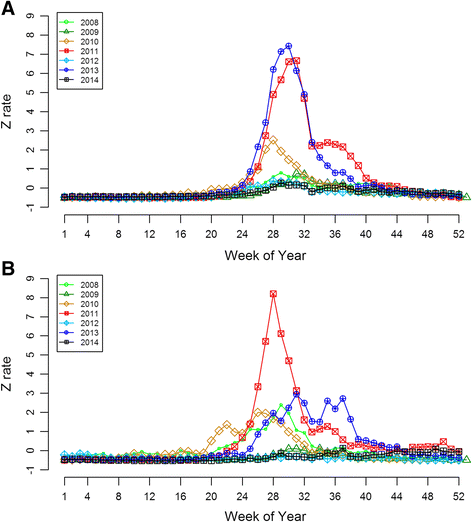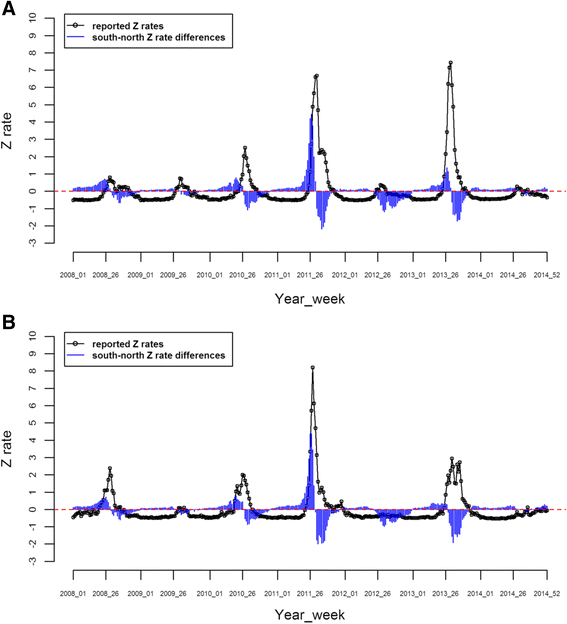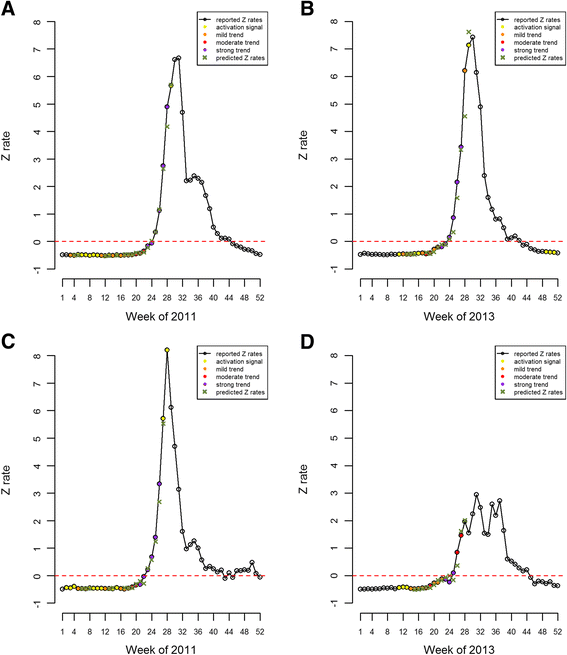Latitude-based approach for detecting aberrations of hand, foot, and mouth disease epidemics
- PMID: 26703896
- PMCID: PMC4691017
- DOI: 10.1186/s12911-015-0236-5
Latitude-based approach for detecting aberrations of hand, foot, and mouth disease epidemics
Abstract
Background: Epidemics of hand, foot and mouth disease (HFMD) among children in East Asia have been a serious annual public health problem. Previous studies in China and island-type territories in East Asia showed that the onset of HFMD epidemics evolved with increased latitude. Based on the natural characteristics of the epidemics, we developed regression models for issuing aberration alerts and predictions.
Methods: HFMD sentinel surveillance data from 2008 to 2014 in Japan are used in this study, covering 365 weeks and 47 prefectures between 24 and 46° of north latitude. Average HFMD cases per sentinel are standardized as Z rates. We fit weekly Z rate differences between prefectures located in the south and north of a designated prefecture with linear regression models to detect the surging trend of the epidemic for the prefecture. We propose a rule for issuing an aberration alert determined by the strength of the upward trend of south-north Z rate differences in the previous few weeks. In addition to the warning, we predict a Z rate for the next week with a 95% confidence interval.
Results: We selected Tokyo and Kyoto for evaluating the proposed approach to aberration detection. Overall, the peaks of epidemics in Tokyo mostly occurred in weeks 28-31, later than in Kyoto, where the disease peaked in weeks 26-31. Positive south-north Z rate differences in both prefectures were clearly observed ahead of the HFMD epidemic cycles. Aberrations in the major epidemics of 2011 and 2013 were successfully detected weeks earlier. The prediction also provided accurate estimates of the epidemic's trends.
Conclusions: We have used only the latitude, one geographical feature affecting the spatiotemporal distribution of HFMD, to develop rules for early aberration detection and prediction. We have also demonstrated that the proposed rules performed well using real data in terms of accuracy and timeliness. Although our approach may provide helpful information for controlling epidemics and minimizing the impact of diseases, the performance could be further improved by including other influential meteorological factors in the proposed latitude-based approach, which is worth further investigation.
Figures




References
-
- WHO . A guide to clinical management and public health response for hand, foot and mouth disease (HFMD) Geneva, Switzerland: World Health Organization; 2011.
-
- Ang LW, Koh BK, Chan KP, Chua LT, James L, Goh KT. Epidemiology and control of hand, foot and mouth disease in Singapore, 2001–2007. Ann Acad Med Singapore. 2009;38(2):106–112. - PubMed
Publication types
MeSH terms
LinkOut - more resources
Full Text Sources
Other Literature Sources

